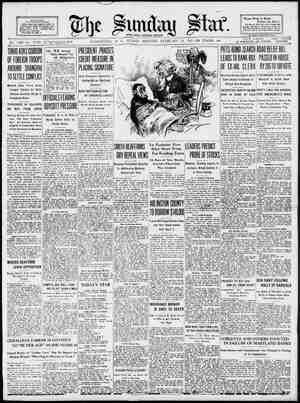Evening Star Newspaper, February 28, 1932, Page 71
You have reached the hourly page view limit. Unlock higher limit to our entire archive!
Subscribers enjoy higher page view limit, downloads, and exclusive features.
Features Art Notes _l | he Sunday St Magasine WASHINGTION, D: €, J Fiction FEBRUARY 28, 1932 e 2 = 20 PAGES. il arBirds of the An American Aviator, Who Has Been in Service for Two Years in China and Was a Daily Companion of Her War Aces, Gives a Vivid Picture of the Military Air Forces of China and Japan and of Flying Hazards Along the Yangtze River. BY BIRGER JOHNSON E were standing near the hangars of the military airdrome at Shanghai. Gen. Chang Hui-chang, commander in chief of the air forces of the Central Chinese govern- ment, had just offered me the command of the finest equipped fighting squadron in the whole Chinese Air Corps, with the rank of a general. Would I accept? I was out of a job. And the equipment of that particular squadron was all that I could have asked. It consisted exclu- sively of the latest Wasp-powered Vought Corsair pursuit fighters, with bomb racks in addition to standard fighting equip- ment. But there were other factors to be con- sidered. I was getting tired of China. I had been there two years, had been ill much of that time and was beginning to feel the urge to get somewhere else. So I shook my head. “No,” I told him. But for that one word, spoken less than a year ago, I might today be in China in command of their prize squadron of fighting planes. And I might be worry- ing my head off about the greatly su- perior air forces of the Japanese; about the powerful Japanese bombers, whose activities over the Chapei district of Shanghai and the Woosung forts have held the attention of the world in recent weeks; about the possibility, in the event of a general war, that immense forma- tions of Japanese planes might sweep up the Yangtze River, bombing the forts” along the way and laying in waste first Nanking and then the new national capi- tal at Loyang, which is 450 miles farther inland. ERHAPS, had I known then that the present trouble was so close at hand, I would have accepted; I don’t know. At that time I had just completed my contract with the China Airways, Inc., an American comvany, for which I had served as senior pilot for nearly two years. I had gone there in the Sum- mer of 1929 and the honor of officially opening the first airmail and passenger run in all of China fell upon me. Sun Fo, the son of China’s great hero, Sun Yat-sen, and one of the leaders in the recent overthrow of President Chiang Kai-shek, was a passenger on that in- augural flight. So was his wife. From Shanghai we flew up the Yangtze River to Hankow, a distance of about 600 miles, with short intermediate stops at Nanking and Kiukiang. Landing fields are few and far between in China, and the only ones available at our ports of call were the military air- dromes. Thus, for nearly two years, I was an almost constant observer of China’s air force, of its equipment, per- sonnel, methods of training, competence and actual mode of carrying on warfare. There I met Gen. Chang Hui-chang, “the Lindbergh of China,” as his country- men call him, a gifted leader, a deadly bomber—as I saw from personal observa= tion—and a skilled pilot, who has been flying ever since 1915. And there I met Gen. Art Limm, the second in command, and many of the other officers and men of the Chinese Air Corps. In my association with them we fre- quently discussed the strength and equip- ment of Japan's air armada, the advan- tage which the war birds of Nippon have in numbers, the problems that would face the Japanese Air Corps were they to at- tempt an air invasion of the interior of China, and similar things. And my daily flights up and down the Yangtze River taught me still more about the problems that would confront any enemy air fleet seeking to reach the interior. Dispatches from Shanghai the other day declared that Chinese soldiers and engineers had been working day and night attempting to uncrate and assem- ble a fleet of 130 airplanes. The planes were not modern birds of war, and had not just been delivered in China. They were out-of-date models that had been shipped from England in 1920; since then they had lain in the original packing cases. No one would take the responsi- bility of attempting to put them together. SUCH hesitancy is readily understood. They tell a story in China that ex- plains it eloquently. Three planes were to be unpacked and assembled. Each part was planly marked with a tag indi- cating where it should go. It seemed a simple enough job, so Chinese mechanics were intrusted with the work. But the assembled planes were queer looking con« traptions. The parts of the three differ« ent models had been mixed indiscrimbe
